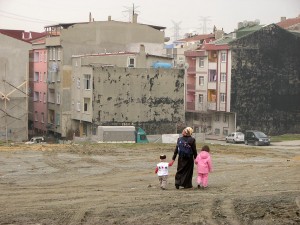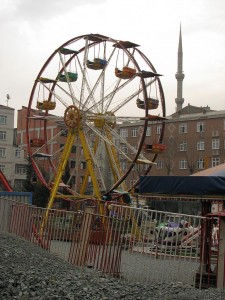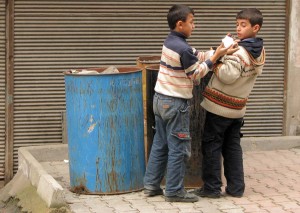After a week in Istanbul it all seemed terribly glamorous, a city of marble palaces and cosmopolitan streets. But I’d read that 400,000 people arrived every year, hoping for work or a better life. There was a ten-million person slum somewhere nearby, but where? In a city that had to be mostly struggling migrants, the poor were completely invisible.
My guidebook mentioned the strife of an immigrant sprawl, but only in a sidebar, never really saying where these people actually lived. Googling “Istanbul slums” gave almost nothing substantial, at least in English. Millions of people simply don’t exist in the infosphere of a Western tourist. Eventually I began to find references to the Gaziosmanpaşa district northwest of the center, with a population of a million or so. With a reported population increase of 79% in the decade 1990-2000, this is an immigrant city risen whole from the fields: migrants from all over the country and sometimes further, speaking Turkish, Greek, Armenian, Kurdish, and Arabic, refugees from rural poverty and violence and the war in neighboring Iraq. Gaziosmanpaşa was on my maps, but just barely, a name on the corner of the page.
“Why do you want to go there?” asked my English teacher acquaintance. She was pretty and professional, clearly as much on the fast track as she could get. “There’s nothing there!” she said. Nonetheless she directed me to a tram line; I took it to the end, a stop named Mescid-i-Selam, approximately 20km from the city center (map).
(click for larger)
What I found was not a slum, not exactly — the structures were permanent, and tangles of electrical wires indicated that it was not a place without infrastructure (such as clean water.) Instead it was your basic third-world suburban sprawl, endless five story apartment blocks interspersed with muddy fields of still-empty land. The architecture mimicked downtown, but shabbily: tile mosaic facades had given way to cracked paint, and mold crept over concrete walls and rough brickwork.
But like every low-class neighborhood, there was obvious life here. Laundry hung from balconies, shops on the corners sold tea or sundries or mobile phones. And children, everywhere children! This was a neighborhood where kids still played in the street, and in this demographically young country there are many children. I turned a corner and found an unexpected amusement park, fraying and closed under winter skies.
Every half dozen blocks a mosque soared over the tenements, regular as churches in England. And, yes, there were headscarves, colorful things on the heads of the girls and women in the streets — though the people in the streets were mostly men. Then a woman appeared entirely in a black abaya, Saudi style, only her eyes visible. For a moment I felt something between pity, revulsion, and fear — until another woman in black joined her, and began arguing with the first, and they were just people again, just old fat grandmothers griping in the street.
A old man walked by with a cane, wearing one of those little knitted Turkish hats. I wondered what village he grew up in, and what changes he’d seen. I wondered what the next generation here would see, and how they would be shaped growing up here, as two young boys found a shiny piece of glass in a construction waste bin.
Satellite dishes sprouted from balconies, blank walls, and rooftops like mushrooms after a rain. The streets were paved and dirty. A line of Thunderbirds ran right through the neighborhood, the towers haphazardly spanning intersections. Men sat on the steps of the mosques and drank tea; I assumed the women were indoors, working, as they always are in the developing world.
But you could make a life here. I have heard that there are shantytowns in other sections of Istanbul, regions of illegally built dwellings without proper power or water or sewage, but these cities are even further hidden to me; I cannot find their names and no tracks will take me there. I know there must be problems in Gaziosmanpaşa — unemployment, domestic violence, illiteracy, and blunted dreams are not something an outsider with a camera can see, nor could I know how many would wait for how many years for legal-immigrant status. Still, this was not the desperate cardboard slums of Mumbai, or the hard favellas of Rio. People smiled as I walked past. A Kurdish street vendor found out I spoke English and was eager to practice with me as I ate his rice and chick-peas off a paper plate. I was a celebrity just by being American, which struck me as sad; but then, I was about to take the tram back to the posh and polished life of the other, visible Istanbul.




Jonathan–After reading about your philosophy on Allison Joseph’s list, I want to write and tell you that I absolutely concur about writing and travel. I don’t write prose inspired by travel, but I write much poetry because of it (so unfortunately I won’t be entering your contest). In fact, a forthcoming chapbook is entirely about travel–“Stroking David’s Leg,” coming from FootHills Publishing. And a small poster-sized broadside on papers I made to hold poems about Italy was released a few months ago by Brick Bat Revue.
Images that come when I travel just won’t leave me alone–not ever. Not long ago I wrote a poem about Bali, and I was there probably fifteen years ago. So it goes.
Have a great time with your contest. I live in Sunnyvale, so if you have any upcoming readings, etc., please let me know. Stray–great name for a traveler.–Best regards, Ellaraine Lockie
You might want to have a rethink on this one, rather than sounding like another dumb Yankee.
I live in a part of Istanbul very much like the one you describe. Power and Water shortages, check. Satallite dishes on every flat piece of wall, check. Rubbish and shit on the street, check. People scrabbling for rubbish. check. Frayed Electrics at every turn, and Illegally built dwellings, check, check and check once more.
But i’ve got news for you. I’m white, and British. 80% of Istanbul is what you would describe as a slum. If your going to leave your plush Taksim or Levent hotel to go out and take some photos, why does it have to be of the ‘darker’ people who have a ‘scary, different’ religion?
On a similar note, your more likely to see the Niqab in England than Istanbul, the women (of which there are less of as getting a job in Europe is harder for Men than Women) were probably out shopping for clothing at a local bazaar rather than being locked indoors and the crime rate is stupidly low – I feel far safer in this city than in London.
So in a nutshell, if you expect places like Istanbul to be like downtown Las Vegas, the whole city is a slum. Thank god you made reference to the differences you may have seen or read about in real impoverished areas of South America and India, ironically two places that have received more of a shafting from western capitalism.
You are right Gaziosmanpasa is not a slum in a third world sence but I think seen from the first world it could still be described as a slum. Other large lower class areas in Istanbul like Ümraniye, Esenler and Esenyurt look very much like it. It probably reflects that Turkey with its 10000$ Gnp/capita is not nearly as poor as many third world countries (gnp often 1000-2000$) but still much poorer than EU /US (gnp 40000$) or so. But much is changing these years as the economy of Turkey is booming. This is seen in Istanbuls rapid transformation – in the 1990s deep crisis poverty was very visible in the city – for instance hundreds of people collecting cardboard in the inner city at night – but today the poverty – at least in the inner city – has given way to fancy shops and cafés and a very cosmopolitan city style.
is there any impact of that?